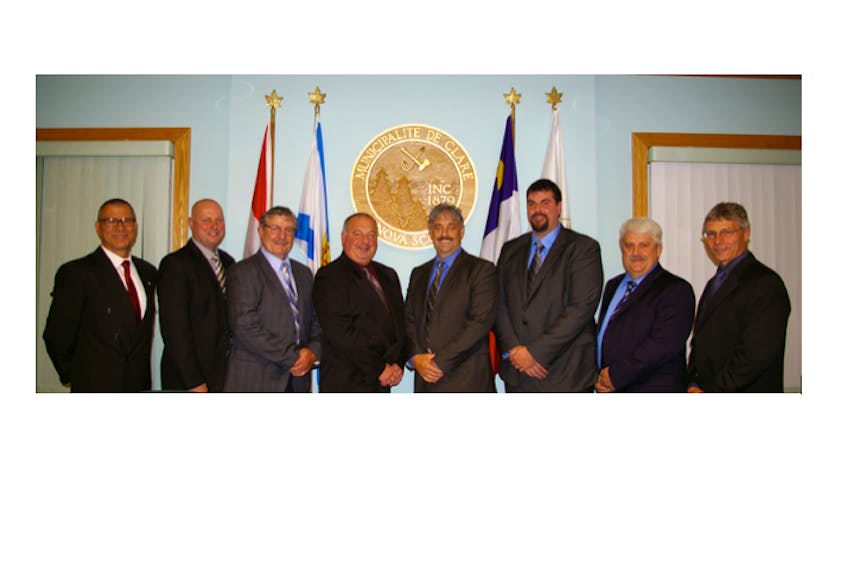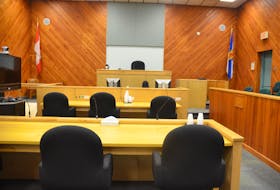LITTLE BROOK, N.S. – An online survey and an upcoming public meeting in Saulnierville are both part of the boundary review public consultations the Municipality of the District of Clare was ordered to undertake by Nova Scotia’s Utility and Review Board in 2016, and, according to a local citizens group, the municipality is now on the right track.
This consultation process marks the third one in four years by the Municipality of Clare to meet the public consultation requirements set out under the Municipal Government Act. The Clare Civic Association (CCA), an ad hoc group of taxpayers in Clare, brought their concerns about the initial public consultation in 2014 to the attention of the UARB. After examining the municipality’s process, the UARB decided the group had legitimate concerns, recognized the CCA with intervener status, and in the last few years, has ordered the municipality to redo their process twice.

Clare Warden Ronnie LeBlanc said they felt they’d done due process, but the Clare Civic Association – and the UARB – did not agree.
“Despite our best efforts at the time, the public consultation process, particularly as it relates to council size, was deemed unsatisfactory by the UARB,” LeBlanc said.
Since 2014, and every eighth year thereafter, the UARB has been required by the Municipal Government Act to conduct a study of the number and boundaries of polling districts in all municipalities across the province, their fairness and reasonableness, and look at their number of councillors.
However, the UARB decided in 2015 and again in 2016 that Clare’s public consultation process, especially as it related to council size, was – in the words of the 2016 UARB decision – “woefully deficient” and credited the CCA and other members of the public with having delivered “compelling submissions” in presenting their concerns about the municipality’s process.
Although the UARB did approve the municipality’s most recent application to maintain eight councillors and also to slightly alter the boundaries of the polling districts in April 2016, the UARB also ordered the municipality to hire a consulting agency and to redo their process, this time including a “proper study regarding the fairness and reasonableness of the number of councillors and polling districts and district boundaries…” which has to be filed no later than Feb. 28, 2018.
LeBlanc said the municipality hired Stantec Consulting Limited, a consulting firm with specific experience in this municipal process, and their team started work on Nov. 30.
Stantec is reviewing the size of the municipal council and the boundaries from which its councillors will be elected. Clare council currently has eight members, including a warden chosen by council members from among themselves after each election to act as their chair.
A survey created by Stantec is available online on the Municipality of Clare website and in print at the municipal office in Little Brook and at the Senator Ambroise H. Comeau Memorial Library in Meteghan. Survey results will be presented and discussed at an initial public meeting on Jan. 16, to be held at the Clare Veteran’s Centre, with an alternate date of Jan. 18 in case of inclement weather.
After the public meeting and review by council, Stantec will map the boundaries of potential districts to be represented by councillors for further review by the public later in January or early February. Following the second public consultation, Stantec will recommend a council size and boundary arrangement to Clare council, which may vote to approve the recommendation, modify the recommendation or develop an alternate recommendation.
The decision of council will form the basis of an application to the UARB for approval of the size of council and electoral district boundaries. If the application is approved, it will fix the size of council and the district boundaries for Clare's next municipal election scheduled for Oct. 17, 2020.
THE PROCESS
Clare Warden LeBlanc said the survey and meetings have been advertised on the municipality’s website, on social media and print ads will appear in the Courier de la Nouvelle-Ecosse, as well as the Clare Shopper.
“The process currently being followed by the municipality was recommended to us by Stantec based on their years of experience with these types of reviews, all of which have been accepted by the UARB,” LeBlanc said.
When asked why they waited until fewer than 60 days of their deadline to start the public portion of the process, LeBlanc said the municipality has a number of competing priorities it must plan and manage.
“The start date and the time allotted for this exercise, including key milestones such as the Jan. 16 meeting, have been discussed with both the UARB and Stantec and, in their professional opinion, are considered adequate. A condensed timeline is conducive to focusing public engagement,” LeBlanc said. “The purpose of this process is to meaningfully consult the public in a fair, open and democratic fashion. As long as the spirit of the exercise is followed and people are afforded the opportunity to speak their mind as to what’s best for the municipality, then I think it’s a win for council.”

Gerard Theriault, chairperson of the Clare Civic Association, however, expressed some frustration over the late start date of the consultation process.
“I don’t know why they waited until the winter to do this,” Theriault said, expressing concerns about possible weather impacts on public participation at the upcoming meeting.
However, unlike the last two times, Theriault approved the current process Stantec has created for the municipality.
“We’re pleased with the process this time and we’re pleased with the consultant they hired. They’ve done this before with other municipalities,” Theriault said. “This is finally being done properly and our association fully supports this process.”
THE COST?
LeBlanc said the current process will cost the municipality in the range of $30,000.
Theriault said the issue is too important to worry about the costs.
“This is important and it had to be done right. The public are demanding this process be completed properly.”
WHAT DOES THE SURVEY LOOK LIKE?
Survey participants are asked whether they live in Clare, did they vote in the last election and would they prefer Clare council to continue with eight members, have fewer members or more members, with a separate question of how many councillors they would like to see, from three to 12.
However, the survey is also set up on an honour system – meaning there is nothing stopping a survey participant from completing the survey more than once, potentially weighting the results.
LeBlanc understood the survey could be completed multiple times by the same person, but said their consultant was monitoring that situation.
”Stantec is aware of this and has processes in place to monitor responses and ensure data integrity,” LeBlanc said, adding, “I sincerely hope residents will respect the importance of having a fair, democratic consultation and abide by the process put forward by Stantec rather than seek to manipulate it.”
Theriault is also aware of the honour system with the survey.
“Yes, it can be completed more than once, but I think they’re controlling that pretty well,” he said, adding, “Most people are honest. I understand it could be stacked one way or the other, but I don’t think that’s much of a concern, or at least I hope not. I like to see a fair system.”
Theriault said he was happy with the survey’s design.
“It’s easy to understand and people should have no problems filling it in. They asked what number of councillors people would like to see, so that was fair.”
WHAT OUTCOME WOULD THEY LIKE TO SEE?
The warden and the Clare Civic Association continue to disagree on the outcome they would like to see from this process, with LeBlanc saying “status quo” is the way forward.
“The current council size of eight allows for good governance and a healthy debate of the issues. It should also be noted that council members sit on a total of 22 boards/committees,” LeBlanc said. “This adds value to a number of important organizations and ensures our municipality is effectively represented at the local, regional and provincial level.
“Although a reduction in council size may save a few dollars, it will no doubt bring with it a high cost in terms of reduced representation, advocacy and community development.”
In their two previous applications to the UARB, Clare council opted to remain with eight councillors.
“Council felt that the current model was working both effectively and efficiently. The lack of calls from the public, other than a select few, for either an increase or decrease to council size seemed to validate council's decision,” LeBlanc said. “There also seems to be this view that if you have fewer councillors, you’ll have fewer arguments or debates, but I think that’s what democracy is all about – bringing different ideas to the table and debating them fully, not making decisions more quickly.”
Theriault said his association would still prefer to see a smaller council in Clare.
“We will agree with whatever the people of Clare decide from filling out their questionnaires, but our group would prefer to see a council of five,” he said. “There are 13 small towns and municipalities in the province and they all have five councillors.”
His list included Digby, Richmond, Barrington and Shelburne.
“They have staff to do the legwork for them – I’m sure Digby has as many items on their docket as Clare has. This municipality is the third smallest in the province – Richmond is larger in territory and larger in residents and they went from nine councillors to five.”
Theriault expects the survey respondents will also agree with his group’s preference.
“I’ll be very surprised if the survey doesn’t go for a smaller council – and then they won’t have a choice – they will have to listen to the people.”
COUNCILLOR COMPENSATION
LeBlanc said his municipality is in good financial shape, and that the remuneration for council is “fair and in keeping with other municipal units.”
“I don’t have the exact numbers right off the top of my head,” LeBlanc said. “I can, however, say that councillors, the deputy warden and the warden for the Municipality of Clare receive approximately $20K, $22K and $30K per year respectively. These figures are disclosed annually in the municipality’s audited financial statements which are available to the public,” LeBlanc said.
When asked if a smaller council could mean a higher remuneration for its members, LeBlanc said he doesn’t think compensation is the issue when it comes to attracting new people to the table.
“If anything, I believe the sizeable time requirements and not councillor remuneration are what may discourage potential candidates to run for council,” LeBlanc said.
Theriault, however, believes the current compensation for Clare council is higher than other areas and that the job is meant to be part-time.
“Their current salary is not bad for Clare for a part-time job, and don’t forget, one third of that is tax free,” Theriault said, adding that his group has done the math. Theriault handed over a piece of paper that stated: the per-person cost of each councillor per constituent in Clare was $20.90, in Digby $19.70 and in Richmond, $15.71.
WHAT IS THE CLARE CIVIC ASSOCIATION?
Theriault said the Clare Civic Association is like a local taxpayer association, and explained the group was formed about eight years ago under the leadership of Paul Christophe Comeau, a former warden of Clare. The association’s mission statement declares they assist in promoting the interests and future of the community of Clare with priority issues including the cost of governance, the size of municipal council and its related expenses.
Theriault said they currently have about 25 members, although he admits only half a dozen of those are really active. The group meets on an irregular basis and is not open to the public except by invitation.
“We’re not registered as an organization because we don’t have much money – we only charge our members $10, but we’re like a taxpayer association,” Theriault said.
When asked who their members are, Theriault shook his head. “No, we don’t give out the names of our membership – because for some people it’s a privacy issue – some of them may be involved with the municipality in some way – so they might be concerned about conflict of interest.”
But Theriault says they don’t have an axe to grind with the municipality.
“When we formed, we received a letter from the warden of the day that he wanted to cooperate with us,” Theriault said. “We’re more of a shadow council – looking at what they’re doing and trying to improve what they’re doing.”
Theriault said in the past his group tried to get the council to move to a system where the warden was elected at large.
“But that’s a dead issue now,” Theriault said. “They won’t do it.”
However, he said his group has already had what they consider a success by insisting the council ask its members about conflict of interest before discussing items on their agenda.
“They never used to do that, so we pointed out to them that they had to,” Theriault said. “And now they ask.”
Theriault said he has always had an interest in politics and the political process and that his group members simply share that interest in local politics. “Local politics is important – they’re the closest government to us – and they spend our money, so why wouldn’t you get involved?”
LeBlanc, however, said he has some ongoing concerns about the Clare Civic Association and the identity of its members.
“While civic associations can and do play an important role, the fact that this particular group is not a registered organization and refuses to disclose its membership makes it impossible to ascertain whether they're speaking for a select few or for the broader community,” LeBlanc said. “I think this group, like all others within the municipality, are entitled to their opinion. However, in this particular instance, I think the lack of public outcry and engagement in the two previous boundary reviews is telling.
“This notwithstanding, we are committed to this current process and want to make sure that the residents of Clare wishing to have their voices heard on this issue have the opportunity to do so.”
For more info about this process and survey visit: www.clarenovascotia.com/en/boundary-review









